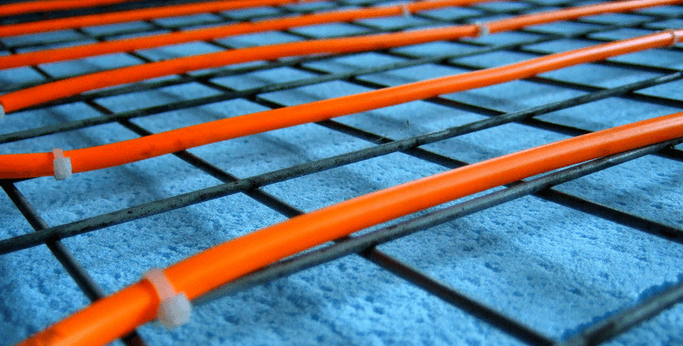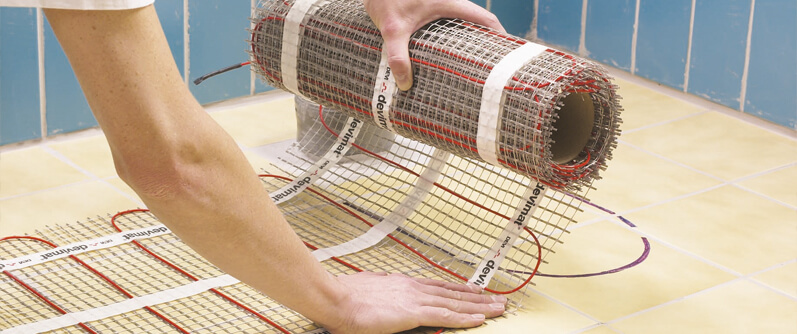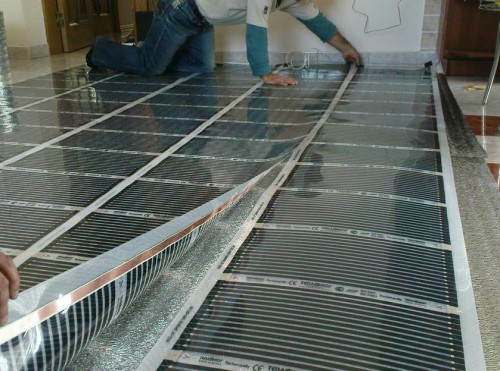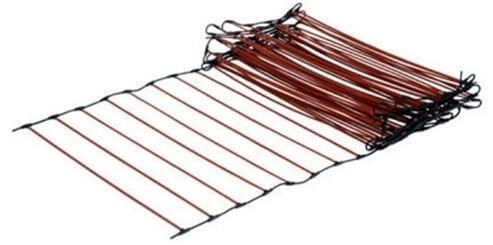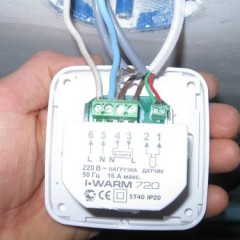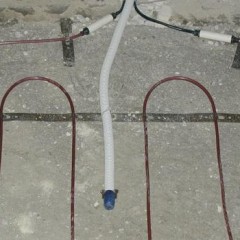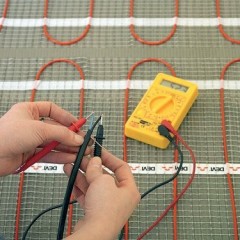The main types of electric floor heating
Existing System Options
Heating cable
Heating with a heating cable in the underfloor heating system appeared earlier than all the others. Despite this, this type of heating is still popular, successfully competing with more modern heating elements.
The principle of operation is that a special conductor is laid on the prepared surface, which converts electrical energy into heat. For the functioning of such a system, it is necessary to pour a concrete screed over the cable, with a thickness of 2 to 5 cm. When the solution solidifies, you can proceed to the finishing work. It is recommended to lay ceramic tiles on top of the heating cable. How to implement installation of underfloor heating under tileread in the corresponding article. As for parquet, laminate and linoleum, their use is limited and negotiated on the packaging individually.
The advantage of a heating cable is as follows:
- low cost;
- It keeps heat even after a shutdown, which to some extent saves electricity.
At the same time, the disadvantages of this type of electric floor heating are:
- reduced electrical safety;
- the complexity of repairing the system (it will be necessary to break the concrete screed);
- the difficulty of correctly calculating the length of the conductor;
- it overheats and fails if it does not fit snugly to the screed, as well as if furniture is placed above the bedding of the conductor.
Most often, this type is used when installing heating in the bathroom, kitchen and bath.
Thermomats
A more advanced type of electric underfloor heating is special heating mats. Products exist in two varieties: convection and infrared.
Convection mats are an advanced model of cable, which in this case is fixed on a mesh basis. The material is sold in finished rolls, the width of which can vary. As in the case of the cable, concrete screed or tile adhesive up to 2 cm thick is poured on top of the thermomat (note that the thickness in this case is less). As a finishing material, it is also recommended to give preference to ceramic tiles.
The advantages of this type of electric underfloor heating:
- less labor-intensive styling;
- simpler calculation of the required material area;
- affordable price;
- screed thickness should be less.
The main disadvantages are:
- the difficulty of repairing a damaged area in the screed;
- fire hazard (in fact, as with a conventional wiring route located in the wall).
Installation of electric mats is carried out according to the following procedure:
Film coating
An improved type of floor heating is a special film with a thickness of less than a millimeter. Laying a film underfloor heating necessarily carried out “dry”, that is, without the use of concrete screeds. That is why the option with ceramic tiles on top disappears. Most often, a parquet board or laminate is laid on top of the film.
The advantage of such a coating:
- spends less electricity;
- does not require special installation skills;
- preparatory work is minimized - you just need to level the surface;
- Suitable for underfloor heating.
Among the shortcomings are:
- increased cost of material;
- the film is afraid of water, which requires the creation of high-quality waterproofing;
- fire hazard is higher than that of other types of underfloor heating (which is associated with the absence of fire-resistant concrete screed);
- it is damaged during significant mechanical loads (if a heavy cupboard or sofa is crushed from above);
- cools instantly when turned off.
DIY technology for installing a film underfloor heating:
Core mats
Well, the last kind of heating elements for floor heating - carbon floor heatingrepresented by core mats. This type of heating system is represented by electrical conductors based on carbon fiber. Carbon mats are most often used for installation under tiles, placing them in tile glue or a 3-centimeter screed.
Of the advantages of this option of electric heating, I would like to highlight:
- high rate of corrosion resistance;
- fire safety of this type of heaters;
- rods can be used in rooms with high humidity;
- even if one of the rods is damaged, floor heating can still function;
- self-regulating properties, which eliminates the overheating of the rods and premature failure.
There is only one drawback - core mats are always packed in a screed.
Installation instructions for carbon mats provided on video:
Which species should I prefer?
As you already understood, depending on whether the tile will be a floor covering or parquet, the selection of a suitable type of electric underfloor heating is carried out.
For a wooden coating (in the bedroom, living room or hall), it is best to use an economical infrared film. To make a warm floor in the bathroom or in the kitchen, you need to give preference to a thermo. We do not recommend using a heating cable, as it is harder to lay and more time will be required to solidify a 5-centimeter screed. In addition, these 5 cm will negatively affect the height of the ceiling, making it lower.
That's all I wanted to tell you about what types of electric underfloor heating exist and the scope of each embodiment. We hope that now you know what type of heating is better to choose for your own application conditions! We also recommend watching a video review, which clearly shows what types of floor heating systems are:
Useful to read:

